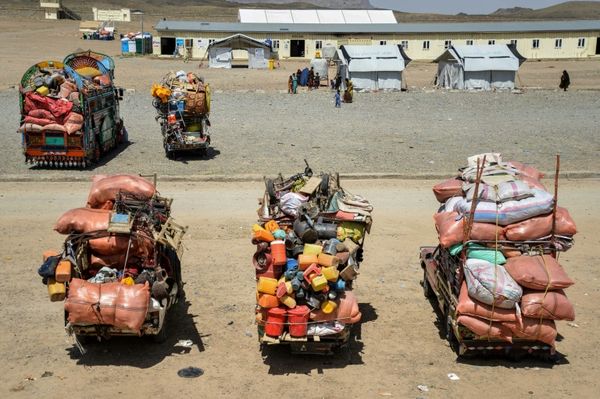
The Australian dollar plunged to pandemic-era lows, the ASX fell and crypto prices were smashed as investors scrambled on Monday to prepare for a global trade war sparked by Donald Trump’s new tariff regime.
Traders even cashed out of gold, a historical safe haven, in a push to raise cash reserves to protect against what could turn into a wave of margin calls.
Markets around the world followed suit with the the S&P 500 in New York dropping 1.6% at the opening bell while earlier the FTSE 100 share index in London lost 106 points to hit 8,570 points.
The US president has set in train 25% import taxes for Canada and Mexico across all products other than Canadian energy, which will face a 10% tariff. China will also face 10% tariffs, with the new impositions scheduled to start on Tuesday.
The targeted nations have started to retaliate.
RBC Capital Markets global head of foreign exchange strategy, Elsa Lignos, said the market was split between those who saw the tariffs as a “big shock that we weren’t priced for” and those who believed Trump will strike deals leading to the removal of tariffs in the coming weeks.
“I’m sitting in the former camp,” Lignos said.
Lignos no longer thought that Trump’s main goal was to “extract a win” in trade negotiations. Rather, she said it appeared that the US president believes tariffs are going to be the new income tax.
Australia’s benchmark S&P/ASX200 index shed more than 1.8% of its value by late afternoon. Futures markets are pointing to similar declines in US equity markets when trading resumes.
But the falls have been more dramatic in other asset classes, with the Australian dollar sinking below 61 US cents, a level not seen since March 2020 during a pandemic-led market crash.
The Australian dollar is viewed as a risk currency and highly exposed to China.
Tony Sycamore, an IG Australia market analyst, said China’s response has been relatively measured, given it has promised retaliation. Beijing was yet to announce any new tariffs.
Chinese officials have also said the tariffs violate international trade regulations, and that they’ll file a complaint at the World Trade Organization.
While bitcoin was down a sharp 7% on Monday to trade below $US94,000, the world’s second-biggest cryptocurrency, Ethereum, shed 25%, representing a huge price decline even by the volatile standards of digital currencies.
Interest rates
The market ructions coincided with the release of Australia’s latest retail figures, which are proving resilient in the face of persistent cost-of-living pressures.
While Australian retail trade dipped in December after many shoppers took advantage of Black Friday sales to buy Christmas presents the month before, sales are up 4.6% from a year ago.
Spending on household goods was robust in December, rising 1.6%, while households cut back on their typical clothing and footwear purchases.
AMP economist My Bui said the Reserve Bank of Australia was still on track to cut the official cash rate next month despite the robust headline figures.
“The rebound in household goods spending has also been driven by many promotional events such as earlier Black Friday sales and Cyber Monday, which was in December this year, meaning consumers are still bargain hunting,” she said.
The market is pricing in a 95% chance of a 25 basis-point rate cut this month, supported by recent data that found inflationary pressures were easing. Australia’s big four retail banks are all forecasting a rate cut.
Financial comparisons site Canstar said on Monday that National Australia Bank was the first of its peers in 2025 to announce cuts to its fixed rate mortgages ahead of the RBA’s decision, due on 18 February.







